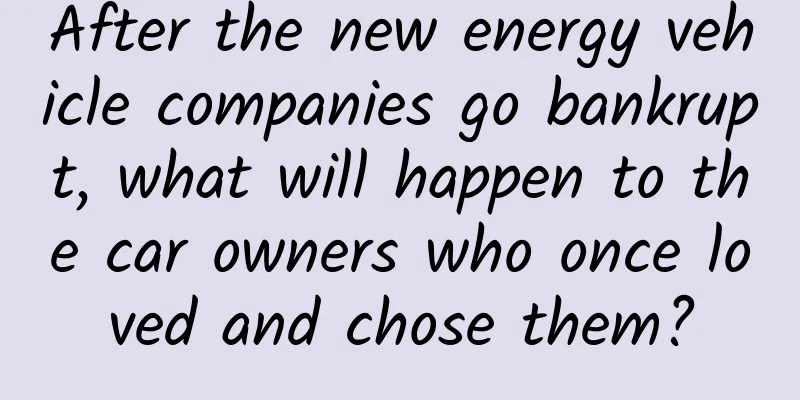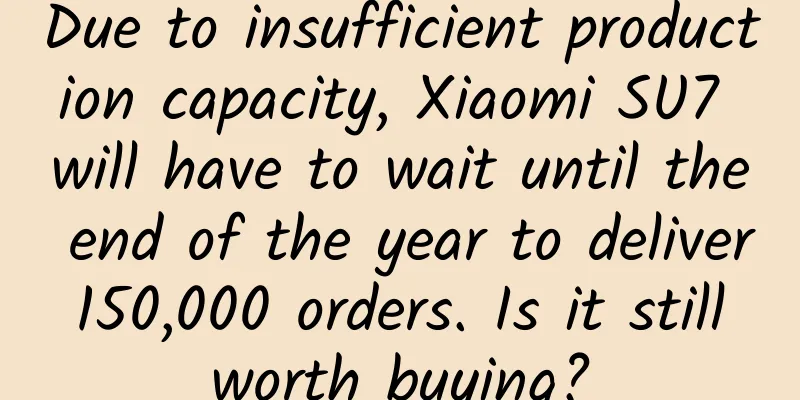After the new energy vehicle companies go bankrupt, what will happen to the car owners who once loved and chose them?

|
The past month may not have been a pleasant one for Mitsubishi Motors owners. At the end of last month, the Nihon Keizai Shimbun reported that Mitsubishi Motors had decided to withdraw from the Chinese market, although Mitsubishi Motors' public relations director later said that this was still an uncertain thing. But in fact, for practitioners who pay attention to changes in the automobile market, Mitsubishi Motors' withdrawal from the Chinese market is just a matter of when it will be officially announced. The long-term sluggish sales and Mitsubishi Motors' indifference to the Chinese market have already discouraged countless dealers and consumers. However, what worries us most is who will provide after-sales service for Mitsubishi owners after Mitsubishi Motors withdraws from the Chinese market? Can spare parts be guaranteed to be in sufficient supply? All these are unresolved issues. But what we are going to talk about today is not the after-sales problems of Mitsubishi Motors, but the after-sales problems of new energy car owners who are facing or will soon face the same problems as Mitsubishi owners. After all, compared with the swing of whether to withdraw or not to withdraw from fuel vehicles, new energy car manufacturers often make changes quietly without making a fuss, such as the recent WM Motor. Recently, many WM Motor owners have discovered that their cars suddenly cannot be connected to the Internet because the car manufacturer has withdrawn. This raises a question: After the new energy car companies go bankrupt, how will the car owners who once chose to trust them and acquired cars solve the after-sales problems of their vehicles? New energy vehicle companies, bankruptcy and exodusIn 2014, as Tesla delivered the Model S to Chinese car owners for the first time, the seeds of building a new generation of domestic new energy vehicle companies were quietly planted in the hearts of a number of entrepreneurs. New car companies such as WM Motor, NIO, Xpeng and Ideal have emerged one after another. Although domestic consumers did not trust these newly-emerged new car companies at that time, the capital market gave them very high valuations and invested a lot of money to support their development. As time goes by, more and more small new car companies have emerged one after another. The reason is simple: the low technical threshold of new energy vehicles, especially electric vehicles, has allowed entrepreneurs with capital to see the opportunity to get a piece of the pie in the automobile market. So everyone rushed in, and the market from A0 to B was filled with names that consumers had never heard of. However, as the battle intensified, or more precisely, as the price of raw materials for power batteries dropped significantly at the beginning of the year, more and more automakers began to launch models with large-capacity batteries. Small new car companies that originally stuck to the A0-class market, which was looked down upon by the giants, were forced to enter the A-class and B-class markets. However, they soon came into direct confrontation with traditional independent car companies such as Geely, Changan and Chery, which have invested a lot of resources in betting on the new energy market this year. Everyone knows the story that follows. It was difficult for them to cope with the huge investments from traditional car companies, difficult for them to cope with the three new forces, namely, NIO, Xiaopeng and Li Auto, which were far ahead in terms of intelligence, and difficult for them to maintain the low- and mid-end markets on which they relied for their success. As a result, new forces such as WM Motor, Aiways, Reading, Horizon and Qiantu went bankrupt in the first half of this year. For the founders of these small new car companies, the bankruptcy of the company means only a failure of their own business. However, for consumers, it means the loss of after-sales service for new energy vehicles that they have bought for less than two or three years. They can neither get repair parts from the official nor use third-party parts for repairs due to many reasons such as the non-interchangeability of parts between different brands and the low ownership of their own models. Therefore, it can be said that they bought a disposable car. So what should consumers do to avoid the lack of after-sales service caused by the bankruptcy of new energy vehicle companies? One of the most effective methods is to choose car companies that have brand continuity, outstanding performance in the new energy vehicle market, and a certain degree of risk resistance, such as traditional brands such as BYD, Volkswagen and GAC Aion, and new energy brands such as NIO, Xpeng and Ideal, rather than blindly pursuing cost-effectiveness and choosing the so-called "parameter king". However, although consumers can try to avoid after-sales risks after the collapse of new energy vehicle companies through these efforts, this is only what consumers can do before buying a car. If they want to fundamentally solve the after-sales risks of consumers when purchasing new energy vehicle companies, there are only two ways to go. Industrial alliance and parts standardization are the fundamental solutionsIn the last century, in order to reduce the cost of technology research and development and supply chain procurement costs, Renault, Nissan and Mitsubishi jointly formed the Renault-Nissan-Mitsubishi Automotive Alliance. Relying on sincere cooperation, they have achieved very good sales results in the world with the label of high cost performance + technological leadership. Although the Renault-Nissan-Mitsubishi Automotive Alliance is a case in the era of fuel vehicles, it is undoubtedly a form of industry cooperation worthy of reference for the current domestic emerging car companies. So the first method we want to propose is industrial alliance. One of the benefits of industrial alliances is that small emerging car companies can jointly research and share technology, reduce their R&D investment, and avoid reinventing the wheel. For example, in terms of R&D platforms, small new forces that do not have sufficient resources can jointly develop platforms, and then develop their own models based on the platform. In this way, the R&D costs of the platform can be spread through high sales. After all, when the technical strength is almost the same, there is basically not much difference in the platform technology that each car company can provide. Another benefit is that purchasing auto parts in a centralized and large-volume manner can reduce procurement costs. For those who have purchasing experience, this is very easy to understand. From the supplier's perspective, if a customer purchases a large enough quantity of products, then in order to retain the customer's order, the supplier will usually give a discount of 1 point or more, which can save a lot of money in purchasing for new energy vehicles with a price of 100,000 yuan or more. The reason why the 2023 Xiaopeng G9, which was released not long ago, can achieve a higher profit margin than the previous generation while reducing its price is precisely because Xiaopeng has obtained the qualification to use the Volkswagen procurement network, which gives it a huge price advantage in component procurement compared to the past. Secondly, accessories are standardized. Although we often say that the current new energy vehicle market is very similar to the smartphone market many years ago, with various forces fighting each other and eventually ending up in a mess, it must be said that for the majority of consumers, the purchase cost of a new energy vehicle is much more expensive than a smartphone worth several thousand yuan, and the replacement of accessories is of paramount importance. No matter how many promises of free lifetime repairs and maintenance the car company made when you bought the car, once the car company went bankrupt, basic repair parts will be difficult to find. The biggest reason for this is that each car company has exclusive customized accessories, which cannot be shared with other companies. The problem of lack of repair spare parts due to the bankruptcy of car companies has frequently occurred in the era of fuel vehicles, and it has become more and more serious among new car companies. Therefore, in order to fundamentally safeguard the interests of consumers, new energy vehicle companies, and even all new energy vehicle manufacturers, have achieved standardization in some core components, such as the smallest integrated unit of the power battery. This can effectively ensure that after the car company goes bankrupt, consumers can also replace some power battery modules for new energy vehicles through third-party channels to prevent the problem that the car company goes bankrupt and the battery cannot be replaced and can only be scrapped along with the vehicle. In this way, it can not only solve consumers' concerns about maintenance after purchasing new energy vehicle companies, but also reduce the procurement costs of new energy OEMs through component standardization from the source, and is beneficial to the environment. Conclusion: Only by caring about consumers can we go furtherIn short, for consumers, if they want to avoid pitfalls and not face after-sales problems due to the bankruptcy of car companies, there are actually not many preventive measures they can take. That is, they should keep their eyes open when choosing a brand, and not choose a new brand with an uncertain future because of its temporary high cost-effectiveness. To truly solve the after-sales problems caused by the bankruptcy of car companies is what car companies should do more, and if they can persist in doing so, then in the long run, the benefits brought to car companies will be obvious. For example, as we mentioned in the previous article, small new car companies can form industrial alliances to reduce the purchase price of auto parts, standardize the technology of the auto platform, and thus standardize the parts. This will not only consolidate consumers' confidence in their brands, but also help enhance the supply chain's confidence in their sales. It can also help small new car companies to gather together for warmth during the capital winter. This is obviously a very correct choice for small new car companies that really want to build good cars and treat car manufacturing as a long-term business. After all, only by caring about the feelings of consumers can they go further in the market. For those car companies that just want to make a fortune by taking advantage of the trend, it is difficult to make money nowadays, and it is also difficult to survive in the extremely involuted market. As a winner of Toutiao's Qingyun Plan and Baijiahao's Bai+ Plan, the 2019 Baidu Digital Author of the Year, the Baijiahao's Most Popular Author in the Technology Field, the 2019 Sogou Technology and Culture Author, and the 2021 Baijiahao Quarterly Influential Creator, he has won many awards, including the 2013 Sohu Best Industry Media Person, the 2015 China New Media Entrepreneurship Competition Beijing Third Place, the 2015 Guangmang Experience Award, the 2015 China New Media Entrepreneurship Competition Finals Third Place, and the 2018 Baidu Dynamic Annual Powerful Celebrity. |
Recommend
Unraveling the Google DevOps puzzle: What qualities make for a world-class, reliable system?
Randy Shoup, who helped lead engineering teams at...
2019 Complete Plan for Online Event Promotion!
How to plan an online event? Even those who are j...
How to warm up for event operation and promotion?
A complete event includes four links: preliminary...
Will smart homes be a passing fad?
When the four words "smart home" come ou...
B-side, the most effective way to acquire customers
Customer acquisition has always been a top priori...
Pregnant women eating hawthorn may cause miscarriage? What prejudices do you have about hawthorn?
gossip In autumn and winter, there is a kind of f...
What is the refraction of light? Why does light bend downward when it enters water, while chopsticks in water bend upward?
Many people have this question. The explanation i...
Honda's global electrification business will accelerate in 2024 ~ Electrification business initiatives and investment strategies
On May 16, 2024, Honda held a press conference ma...
Electric Technology Car News: Both the appearance and connotation make you give up Korean cars. Which one is better, the Tiggo 7 or the Roewe RX5, both domestic high-quality SUVs
In the Chinese SUV market, which is like a flouri...
You may not know these updates! Android 9.0 has these interesting features
Google has released the latest generation of Andr...
Seth Klarman is a truly great book
I took a lot of notes while reading this book, es...
There will be significant rainfall in North China, Huanghuai, Northeast China, etc. Beware of sudden rainstorms in Jiangnan and South China! Pay attention during the rainfall →
The Central Meteorological Observatory predicts t...
Why has Tik Tok become a great tool for promoting products?
Why is Tik Tok so magical in promoting products? ...
Facebook advertising tips!
There seem to be many reasons why Facebook reject...
91 Ten Articles: Ford executive Zhu Jiang may join Xiaomi Motors, Volkswagen electric vehicle deliveries doubled
1. Zhu Jiang, Chief Operating Officer of Ford Chi...









